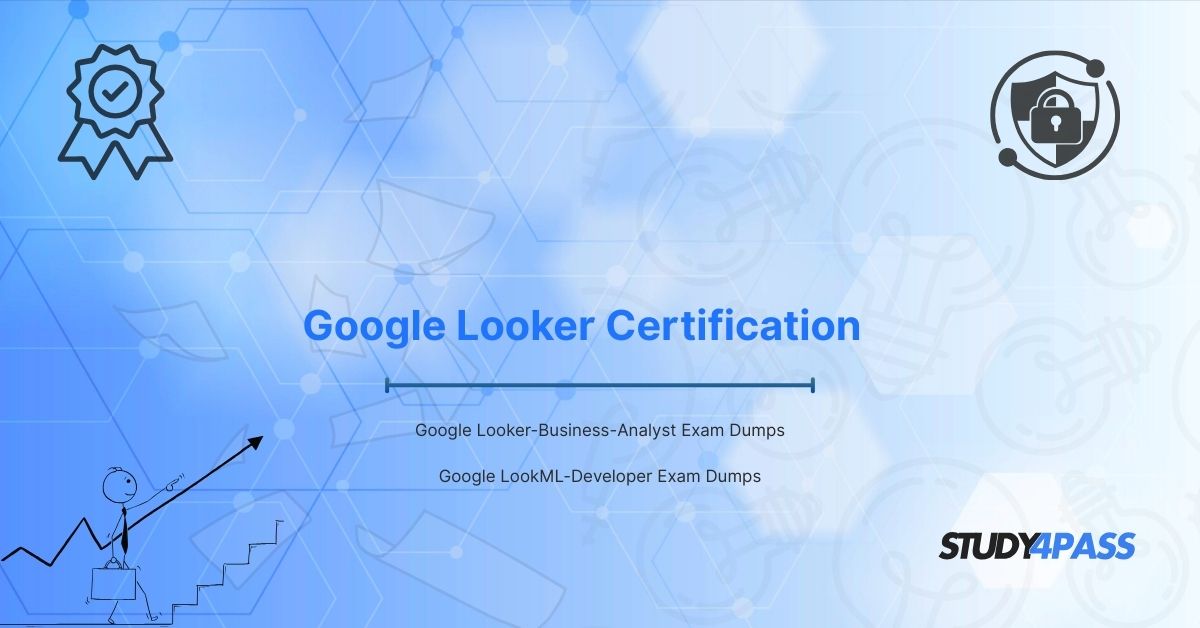Introduction to Google Looker Certification Exam Prep Practice Test
Earning a Google Looker Certification is a prestigious achievement that validates your expertise in data analytics, business intelligence, and LookML development. However, preparing for these exams can be challenging without the right resources. That’s where Study4Pass comes in!
At Study4Pass, we provide high-quality Google Looker exam prep practice test that help you prepare efficiently. Our real exam-like questions and answers ensure you gain the confidence and knowledge needed to pass on your first attempt. Whether you're aiming for the Google Looker Business Analyst or Google LookML Developer certification, our resources are tailored to help you succeed.
Google Looker Certification Overview
Google offers two primary Looker certifications:
1. Google Looker Business Analyst Certification
- Focuses on data exploration, dashboard creation, and business insights using Looker.
- Ideal for professionals who analyze data and present findings to stakeholders.
2. Google LookML Developer Certification
- Centers on LookML modeling, SQL optimization, and data governance.
- Best suited for developers and data engineers who build and maintain Looker models.
Both certifications require a deep understanding of Looker’s functionalities, and passing them demonstrates your proficiency in data analytics and BI solutions.
Official Google Looker Certification Study Resources
Google provides several official resources to help candidates prepare:
- Looker Documentation: Comprehensive guides on Looker features, LookML, and dashboarding.
- Google Cloud Training: Instructor-led courses and hands-on labs.
- Looker Community & Forums: Peer discussions and expert advice.
While these resources are helpful, they may not be enough for everyone. Supplementing your study with exam prep practice test from Study4Pass can significantly boost your preparation.
Recommended Study Materials
To maximize your chances of success, combine official resources with Study4Pass exam prep practice test, which include:
Updated Exam Questions – Mimicking the actual test format.
Detailed Explanations – Helping you understand concepts, not just memorize answers.
Practice Tests – Simulating real exam conditions for better time management.
Additionally, consider these study materials:
- Looker Quick Start Guide – For beginners.
- LookML Development Best Practices – For advanced users.
- YouTube Tutorials – Visual learners can benefit from step-by-step demos.
Study Tips & Strategies
1. Understand the Exam Blueprint
Review the official exam guide to know which topics carry the most weight.
2. Hands-on Practice
Work on real Looker projects or use sandbox environments to apply theoretical knowledge.
3. Take Mock Exams
Use Study4Pass practice tests to identify weak areas and improve accuracy.
4. Join Study Groups
Collaborate with peers preparing for the same exam to exchange insights.
5. Revise Regularly
Spaced repetition helps retain information longer.
Additional Resources
Looker Webinars – Free sessions by Google experts.
Study4Pass – Study real-world Looker projects.
Study4Pass Blog – Tips, tricks, and success stories from certified professionals.
Conclusion
Passing the Google Looker Certification exam requires dedication, the right resources, and strategic preparation. While Google’s official materials are a great starting point, Study4Pass exam prep practice test provide the extra edge needed to ace the test confidently.
Start your journey today with Study4Pass and take the first step toward becoming a Google Looker Certified Professional!
Special Discount: Offer Valid For Limited Time “Google Looker Certification”
Actual Exam Questions from Google Looker Certification
What is the primary purpose of Looker’s "Explore" feature?
A) To write SQL queries manually
B) To visualize data through drag-and-drop interface
C) To schedule data exports
D) To manage user permissions
In LookML, what does the "view" parameter define?
A) A single database table or derived table
B) A user’s dashboard access level
C) A type of visualization
D) A scheduled report
Which Looker feature allows you to share dynamic dashboards with external stakeholders?
A) Looker Blocks
B) Scheduled Deliveries
C) Embedding
D) PDTs (Persistent Derived Tables)
What is the correct syntax for defining a dimension in LookML?
A) measure: dimension_name { type: string }
B) dimension: dimension_name { type: string }
C) field: dimension_name { type: dimension }
D) column: dimension_name { datatype: varchar }
Which of the following is NOT a Looker visualization type?
A) Bar Chart
B) Scatter Plot
C) Sankey Diagram
D) Neural Network Graph


